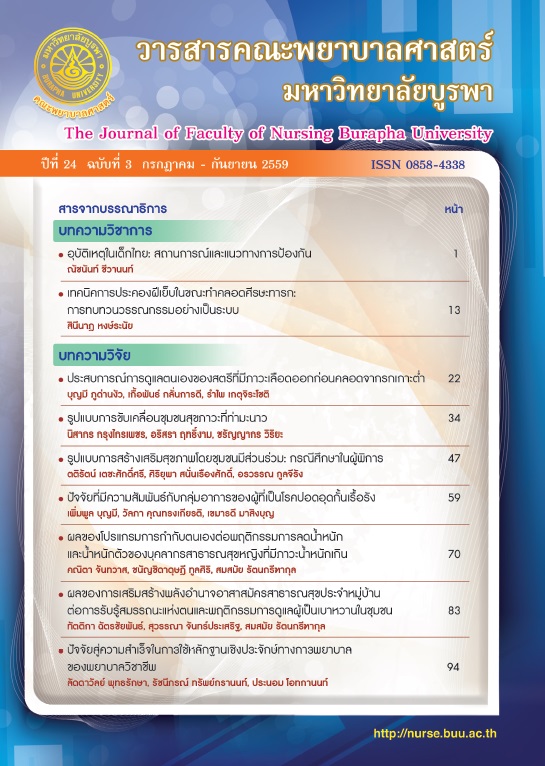ปัจจัยที่มีความสัมพันธ์กับกลุ่มอาการของผู้ที่เป็นโรคปอดอุดกั้นเรื้อรัง
คำสำคัญ:
กลุ่มอาการ, ผู้ที่เป็นโรคปอดอุดกั้นเรื้อรัง, Symptom clusters, persons with chronic obstructive pulmonary diseaseบทคัดย่อ
บทคัดย่อ
การวิจัยครั้งนี้เป็นการวิจัยเชิงพรรณนาหาความสัมพันธ์เพื่อศึกษาปัจจัยที่มีความสัมพันธ์กับกลุ่มอาการของผู้ที่เป็นโรคปอดอุดกั้นเรื้อรัง กลุ่มตัวอย่าง คือ ผู้ที่เป็นโรคปอดอุดกั้นเรื้อรังที่เข้ารับการรักษาในคลินิกโรคปอดอุดกั้นเรื้อรัง แผนกผู้ป่วยนอกโรงพยาบาลปักธงชัย จำนวน 126 ราย คัดเลือกกลุ่มตัวอย่างตามเกณฑ์และสุ่มอย่างง่าย เครื่องมือที่ใช้ในการวิจัย ได้แก่ แบบสัมภาษณ์ข้อมูลส่วนบุคคล แบบประเมินภาวะโภชนาการ แบบสัมภาษณ์กลุ่มอาการ และแบบสัมภาษณ์การสนับสนุนทางสังคม เครื่องชั่งน้ำหนักและวัดส่วนสูง วิเคราะห์ข้อมูลด้วยสถิติเชิงพรรณนา สัมประสิทธิ์สหสัมพันธ์ของสเปียร์แมน และสัมประสิทธิ์สหสัมพันธ์ของเพียร์สัน
ผลการวิจัยพบว่า ผู้ที่เป็นโรคปอดอุดกั้นเรื้อรังรับรู้ถึงกลุ่มอาการโดยรวมร้อยละ 100 เฉลี่ย 46.06 คะแนน (SD = 28.20) เมื่อพิจารณารายกลุ่มพบว่ารับรู้ถึงกลุ่มอาการด้านจิตใจร้อยละ 96.8 เฉลี่ย 8.52 คะแนน (SD = 5.57) และกลุ่มอาการด้านร่างกาย ร้อยละ 86.5เฉลี่ย 37.54 คะแนน (SD = 24.85) ส่วนปัจจัยที่มีความสัมพันธ์พบว่า ความรุนแรงของโรคมีความสัมพันธ์ทางบวกในระดับปานกลางกับกลุ่มอาการอย่างมีนัยสำคัญทางสถิติ (rs =.44, p < .01) การสนับสนุนทางสังคมมีความสัมพันธ์ทางลบในระดับต่ำกับกลุ่มอาการอย่างมีนัยสำคัญทางสถิติ (r = -.20, p < .05) และภาวะโภชนาการไม่มีความสัมพันธ์กับกลุ่มอาการ (p > .05) ผลการวิจัยครั้งนี้พยาบาลและบุคลากรทางสุขภาพสามารถนำไปใช้เป็นแนวทางช่วยลดความรุนแรงของกลุ่มอาการโดยการลดความรุนแรงของโรคและให้การสนับสนุนทางสังคมในผู้ที่เป็นโรคปอดอุดกั้นเรื้อรัง
Abstract
This descriptive correlation design aimed to study factors related to symptom clusters in persons with chronic obstructive pulmonary disease. The samples were 126 persons with a chronic obstructive pulmonary disease who met inclusion criteria in chronic obstructive pulmonary disease clinic at The Pak Thong Chai Hospital. They were recruited by simple random sampling. The instruments consisted of Personal Information Questionnaire, Nutritional Status Assessment, Symptom clusters Questionnaire, Social Support Questionnaire, weighting and height apparatus. The data were analyzed by descriptive statistic and Spearman rank correlation and Pearson’s product moment correlation.
The results of the study showed that sample perceived symptom clusters 100 %. Mean score of symptom clusters was 46.06 (SD = 28.20). For subgroups, 96.8% of sample perceived psychological symptom cluster and mean score was 8.52 (SD = 5.57). 86.5% of sample perceived physical symptom cluster and mean score was 37.54 (SD = 24.85). For factors related to symptom clusters, disease severity was significantly positively related to symptom clusters at a moderate level (rs = .44, p < .01). Social support was significantly negatively related to symptom clusters at a low level (r = -.02, p < .05). Nutritional status was not significantly related to symptom clusters (p > .05). The result of this research suggested that nurse and health care provider can use to be guidelines for reducing the severity of symptom clusters by decreasing disease severity and increasing social support in person with chronic obstructive pulmonary disease.





